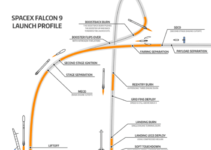Table of Contents
Introduction
Starlink is a constellation of satellite which being constructed by SpaceX to provide satellite Internet access. This constellation will consist of thousands of mass-produced small satellites in low Earth orbit (LEO), working in combination with ground transceivers.
SpaceX intends to provide satellite internet connectivity to under-served areas of the planet, as well as provide competitively priced service to urban areas. The company has stated that the positive cash flow from selling satellite internet services would be necessary to fund their Mars plans. Spacex uses VTVL technology.
Starlink Satellite
LESS MASS, MORE COMPACT
Each satellite weighs approximately 260kg and features a compact, flat-panel design that minimizes volume, allowing for a dense launch stack to take full advantage of the launch capabilities of SpaceX’s Falcon 9 rocket. Read more
ANTENNAS
With 4 powerful phased array antennas on each satellite, an enormous amount of throughput can be placed and redirected in a short time, for an order of magnitude lower cost. Read more
SINGULAR SOLAR ARRAY
satellites feature a single solar array, significantly simplifying the system; solar cells are standardized, and easy to integrate into the manufacturing process. Read more
ION PROPULSION SYSTEMS
satellites are equipped with efficient ion thrusters powered by krypton that enable the satellites to orbit raise, maneuver in space, and deorbit at the end of their useful life. Read more
STAR TRACKER
Custom-built in-house navigation sensors tell each satellite its attitude, which helps enable precision placement of broadband throughput. Read more
AUTONOMOUS COLLISION AVOIDANCE
satellites utilize inputs from the Department of Defense’s debris tracking system to autonomously perform maneuvers to avoid collisions with space debris and other spacecraft. This capability reduces human error, allowing for a more reliable approach to collision avoidance. Read more
Launch 1 – PAZ mission (Tintin) [Success]
February 22, 2018, 14:17 UTC
Two test satellites known as Tintin A and B (MicroSat-2a and 2b) that were deployed as co-payloads to the Paz satellite. The two prototypes are still in orbit.
Launch 2 – Starlink-test mission (60 test satellites) [Success]
May 24, 2019, 02:30 UTC
The first launch of 60 test satellites. These are used to test various aspects of the network, including deorbiting. By five weeks post launch 3 became non-operational and others were healthy.
Launch 3 – Starlink1 mission (60 operational satellites) [Success]
November 11, 2019, 14:56 UTC
The first launch of 60 operational satellites (v1.0), was the first to include Ka-band antennas.
Launch 4 – Starlink2 mission (60 operational satellites) [Success]
January 7, 2020, 02:19 UTC
More 60 operational satellites (v1.0). One of the satellites, dubbed DarkSat, has an experimental coating to make it less reflective, and to reduce the impact on ground-based astronomical observations.
Launch 5 – Starlink3 mission (60 operational satellites) [Success]
January 29, 2020, 14:06 UTC
More 60 operational satellites (v1.0).
Launch 6 – Starlink4 mission (60 operational satellites) [Success]
February 17, 2020, 15:05 UTC
More 60 operational satellites (v1.0).
Launch 7 – Starlink5 mission (60 operational satellites) [Success]
March 18, 2020, 12:16 UTC
More 60 operational satellites (v1.0).
Launch 8 – Starlink6 mission (60 operational satellites) [Success]
April 22, 2020, 19:30 UTC
More 60 operational satellites (v1.0).
Launch 9 – Starlink7 mission (60 operational satellites) [Success]
June 4, 2020, 01:25 UTC
More 60 operational satellites (v1.0). At least one satellite will have a sunshade (VisorSat).
Launch 10 – Starlink8 mission (58 operational satellites) [Success]
13 June 2020, 09:21 UTC
More 58 operational satellites (v1.0). plus three Planet Labs, SkySats 16-18 Earth-observation satellites.
Launch 11 – Starlink9 mission (57 operational satellites) [Success]
7 August 2020, 05:12 UTC
More 57 operational satellites (v1.0). All of them will be outfitted with the sunshade visor that was tested on a single sat on the 4 June 2020 launch. plus two satellites, BlackSky Global 7 and 8.
Launch 12 – Starlink10 mission (58 operational satellites) [Success]
18 August 2020, 14:31 UTC
Again 58 operational satellites (v1.0). plus three SkySats 19-21 Earth-observation satellites for Planet Labs
Launch 13 – Starlink11 mission (60 operational satellites) [Success]
3 September 2020, 12:46 UTC
More 60 operational satellites (v1.0).


If you want to take a good deal from this article then you have to apply these methods to your won web site.